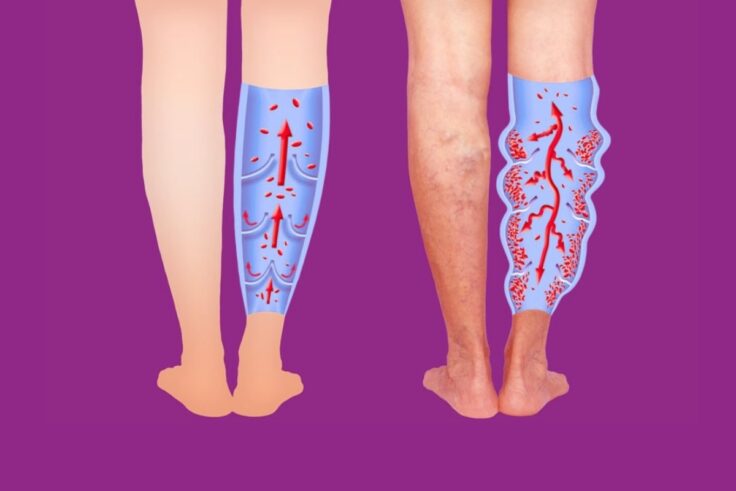Why Leg Veins Appear And How To Reduce Them

In this article, we’ll talk about leg veins, both spider and varicose veins, their causes, signs, and symptoms, and possible treatments.
Almost everybody lacks gratitude for what they have, we are complacent and we only realize what we have when we lose it. When it comes to people’s health, this is especially true.
Leg veins are a common condition for many individuals, and it is something that they will have throughout their lives.
Here, we will try to explain why they arise and how to cure them.
What Types Of Leg Veins Are There?
There are two types of leg veins:
Spider Veins
They are small veins that appear on the surface of the legs or face. Even though they are rarely painful or harmful, some people may wish to have them treated for aesthetic reasons.
Spider veins can be blue, purple, or red, and they can appear as thin lines, webs, or branches.
They’re sometimes referred to as thread veins.
A variety of techniques can be used to remove or decrease spider veins.
Varicose Veins
They are twisted and turning blood vessels that are big, elevated, and swollen. They typically appear in the legs and are visible through the skin.
They are caused by a weakened blood vessel wall or defective valves. They can appear everywhere on the body, although they’re most common in the legs and pelvic area.
The safest piece of advice is to consult a doctor, hence you can check the Ultimate Vein Guide, where you can see information about everything you need to know to solve your issues.
When looking for a vein expert, the first person you should contact is a vascular surgeon. A good doctor will guide you through all of these problems and will make the process easier for you.
How Do They Come to Be?
Varicose veins and spider veins can be caused by a variety of factors. These are some of them:
- Heredity;
- Nurses, hairstylists, instructors, and factory workers are examples of occupations that require a lot of standing, thus being at risk of getting leg veins;
- Obesity;
- Pregnancy, puberty, and menopause all have hormonal effects;
- Taking birth control pills;
- Hormone replacement therapy for postmenopausal women;
- Blood clots history;
- Tumors, constipation, and externally worn items like girdles can all produce increased pressure in the abdomen.
Varicose and spider veins become more common as you become older. Varicose veins or spider veins affect between 30 and 60 percent of adults.
Healthy valves inside veins allow blood to flow backward instead of upwards toward the heart, causing spider veins. Some of this backed-up blood can result in spider veins, which are non-functional, “dead-end” veins that form beneath the skin’s surface.
Varicose veins are caused by an increase in blood pressure in your veins. Blood flow is directed towards the heart through one-way valves. Blood can gather in the veins if the valves become weaker or damaged. Thus, the veins widen.
Leg Veins Symptoms
The most prevalent symptoms of varicose veins are listed below. However, each person may uniquely experience symptoms. Among the signs and symptoms are:
- The skin’s color changes;
- Legs are swollen and inflamed;
- Rash;
- Leg discomfort, such as a heavy sensation, burning, and/or aching.
Possible Treatments
Here are the most important possible treatments for leg veins:
1. Support (Compression) Stockings
Wearing properly fitting support socks is the most conservative method, especially when the veins cause pain or discomfort.
They apply light pressure to the leg. This helps to prevent blood from collecting in veins and reduces leg swelling.
These stockings can be found in most surgical supply stores as well as some pharmacies. They come in a variety of styles, including below-the-knee, above-the-knee, and pantyhose styles.
2. Changes In Your Way Of Life
Varicose and spider veins can be treated with good skin cleanliness, weight loss (if necessary), walking, and exercise. Alternatively, you might try:
- Avoid long periods of standing or sitting without taking a break;
- Lower-heeled shoes can assist tone calf muscles and increase blood circulation in the veins;
- Do not cross your legs at your knees and ankles;
- Elevating your legs, ideally to a level above your heart, whether sitting, resting, or sleeping;
- Physical activities that involve moving your legs enhance muscle tone.
3. Surgery
Ligation (tying off a vein) and stripping are two surgical procedures used to treat varicose veins.
Vein stripping and ligation is a procedure that includes tying veins shut and removing them through minor skin incisions.
The procedure normally takes 2-3 hours and is performed in an outpatient setting. It takes a few weeks to completely recover.
The following are some of the most prevalent negative effects of varicose vein surgery:
- Swelling that could take a few weeks to go away. The feet and ankles are most likely affected.
- Scarring is common, albeit scars are less apparent than varicose veins. With time, the scars disappear.
- Brown discoloration on the skin, which tends to diminish over time.
- In the skin and the calf muscle, there is pain, swelling, and bruising.
The Takeaway
Many people have these types of problems, thankfully many treatments can help people with it.
Hopefully, we were able to present clearly how leg veins are manifested and some ways how to treat them.